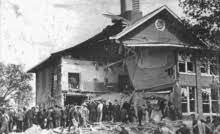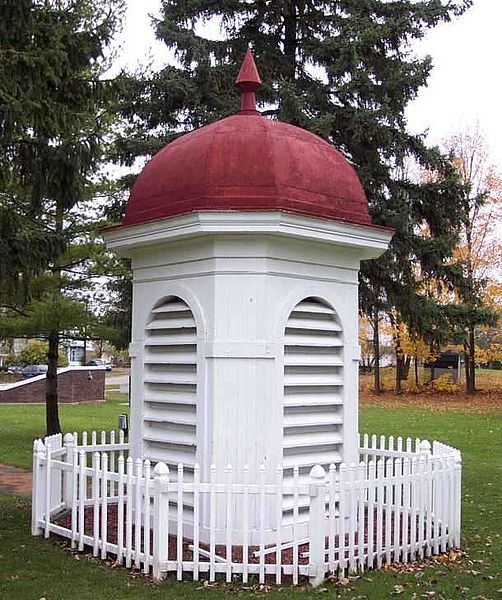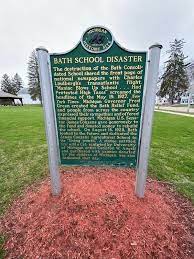
Wikipedia
The front of the badly damaged Bath Consolidated School after the May 1927 bombing.By AMALIA MEDINA
Capital News Service
LANSING – A new museum to memorialize a school bombing is slated for completion by the 100th anniversary of the tragedy in 2027.
The May 18, 1927, bombing of the Bath Consolidated School by disgruntled school board member Andre Kehoe remains America’s deadliest school mass murder.
Thirty-eight elementary children and six adults died, and 58 others were injured.
Kehoe, who had placed timed explosives in the building, murdered his wife and firebombed their farm. He died outside the school when he set off explosives hidden in his truck.
Now, 96 years later, residents are working to keep the memory of the victims alive through a new Bath School Museum northeast of Lansing in Bath Township, Clinton County.
The current museum is in the middle school auditorium lobby and contains school memorabilia from more than a century ago.
The Bath School Museum Committee has proposed building a larger and more accessible museum that also would provide a space for the last remaining part of the original 1922 building – the cupola, which survived the explosions.
In 1975, the original building was torn down because it was in poor condition.
The grounds were turned into the James Couzens Memorial Park, where the cupola is now displayed alongside the memorial and marker commemorating the “Bath School Disaster.”
The cupola has been outdoors for more than a century, and the committee decided to move it indoors to prevent deterioration.
The cupola won’t have to move far, though, since the new museum will be on the edge of the park grounds.
The museum planning comes amid an escalating number of mass shootings across the country. They include the November 2021 shooting at Oxford High School, Oakland County, where a 15-year-old student with a 9 mm semi-automatic handgun murdered four students and injured seven people, including a teacher.
According to committee member Chris Hagerman, Bath residents have shown support for building the museum on the site.
“That’s where the disaster happened, and it’s only fitting to bring it back there,” Hagerman said.
“Some of the older folks whose families have had either someone who was killed or survived the disaster always wanted a memorial in that park, more than just the cupola,” he said.
“Almost everybody who’s talked to us has said how much they’d appreciate having a museum in the park,” Hagerman said.
The museum will cover all of Bath’s school history but emphasize the disaster and its effects, which are felt by township residents today, said Hagerman, whose maternal grandfather, Raymond Eschtruth, survived the attack as a child.
His mother, Susan Hagerman, is president of the committee.
Susan Hagerman grew up knowing something happened, but her dad never talked about it. Because he had been buried alive in the explosion, loud noises upset him and he cried when the topic of the disaster was brought up, she said. His sisters had similar reactions.
“Back then, nobody talked about what happened,” Susan Hagerman said. “Back then, they didn’t have support groups. They didn’t have counselors. Everybody kept everything to themselves. So for the most part, everybody — survivors, family members — they knew what happened, but nobody really talked about it.”
But that changed in the 1970s when the principal gave a presentation about the explosion to mark its 50th anniversary. The presentation included photos from the disaster.
“I sat there and watched that with my dad, and it was like I was right there with them,” Susan Hagerman said. “It was just mind-blowing. But after that point, it seemed like the survivors started opening up more.”
As more people started talking about their experiences, the event’s effect on the community became evident, Susan Hagerman said.
The community always had a rural, small-town environment, she said, and right after the disaster, residents grew even closer.
They were forced to move on quickly, she said.
“After the explosion, there wasn’t a lot of time to grieve because they still had to feed their family,” she said. “They still had to take care of their farm, and take care of animals, besides burying their children.
“Everybody pulled together. People that lost children in the explosion went to funerals of their friends that lost children in the explosion.”
She said the new museum will continue to recognize the event and memorialize the victims.
“It was horrific, but it’s part of our past,” she said.
“It’s important to let younger people know about it because it’s part of our history. There’s still many survivor families in the community. Not only the explosion — it’s important to know the history of our school because that’s part of our past too.” Susan Hagerman said.
Chris Hagerman said there’s plenty of fundraising to do, but he’s confident the community will support the endeavor.
According to committee member Kate Hagerman, Chris Hagerman’s wife, the community response has been overwhelmingly positive.
She said the committee also plans to pursue grants and endowments.
The museum could include a community center with a venue or event space, especially for class reunions.
By creating the museum and community space, Kate Hagerman said the committee hopes residents can tell their stories and continue to lean on each other.
“I think almost all of us have lived in Bath for the majority of our lives or went to school here,” she said. “We’re all really invested and connected. It’s really close to all of our hearts, to make sure that this story is told in the right way going forward.”

James Daggy, Michigan State University
This cupola is the only remaining part of the original school building that was blown up in 1927. It now sits on the site of the bombing.
Historical Marker Database. HMdb.org
This historical marker commemorates the 1927 Bath School Disaster